Development of Detailed Mix Design Methodology for Low Calcium Fly Ash Based Geopolymer Concrete Incorporating OPC and Crumb Rubber
Abstract
:1. Introduction
2. Review of Mix Design Methods and Their Limitations
3. Material Properties
3.1. Fly Ash
3.2. OPC
3.3. Sodium Hydroxide and Sodium Silicate
3.4. Superplasticizer
3.5. Coarse Aggregates
3.6. Fine Aggregates and Crumb Rubber
4. Proposed Method for Designing Rubberized GPC Using Fly Ash and OPC
4.1. Selection of Binder Content
4.2. Fixing the Alkaline Activator Liquid (AAS) to Binder Ratio
4.3. Calculation of AAL Content
4.4. Fixing Sodium Silicate/Sodium Hydroxide Ratio
4.5. Fixing of Water Content in GPC and Calculation of Extra Water
4.6. Superplastizer Content
4.7. Determination of Coarse and Fine Aggregates Content
4.8. Calculation of Crumb Rubber Content and Revised Fine Aggregates Content
4.9. Development of CR–GPC Compressive Strength and Slump Graphs
5. Proposed Procedure for Sample Preparation
- The mixing procedure was performed at room temperature (25–27 °C). First, the dry materials, such as the FA, OPC, CR, and sand, were mixed to achieve a uniform distribution. Then, the alkaline-activator solution of NaOH and Na2SiO3 was progressively added to the mix, followed by the extra water and superplasticizer.
- The fresh GPC of a particular mix design was cast into standard cube molds (150 × 150 × 150 mm), then compacted and immediately covered with a polyvinyl sheet to avoid water evaporation.
- After the casting, the specimens were placed in an oven for steam curing at 60 °C for 24 h, and the relative humidity was maintained at approximately 60%. After the steam curing, the samples were de-molded and allowed to cool at room temperature (25–27 °C) until the testing.
6. Experimental Verification of the Mix Methodology
- (1)
- Fly ash content = 0.8 × 380 = 304OPC content = 0.2 × 380 = 76
- (2)
- AAL content = 0.45 × 380 = 171
- (3)
- NaOH solution = 171/3.5 = 48.85NaOH solids = 0.383 × 48.85 = 18.71NaOH water = 48.85 − 18.71 = 30.14
- (4)
- Na2SiO3 solution = 2.5 × 48.85 = 122.15Na2SiO3 solids = 0.486 × 122.15 = 59.36Na2SiO3 water = 122.15 − 59.36 = 62.78
- (5)
- GPB solids = 380 + 18.71 + 59.36 = 458.07
- (6)
- Extra water = (0.27 × 458.07) − (30.14 + 62.78) = 123.68 − 92.92 = 30.76
- (7)
- Superplasticizer = 0.02 × 380 = 7.6
- (8)
- Volume of the total aggregates in m3 was calculated by using Equation (4), as follows:
- (9)
- Volume of the coarse and fine aggregates was calculated using Equations (5) and (6), as follows:
- (10)
- Crumb rubber = 0.10 × (511.52/2.65) × 1.13 = 21.81Fine aggregates (revised) = 0.9 × 511.52 = 460.37 kg
7. Limitations of the Method
8. Conclusions
- In this study, a mix-design methodology has been suggested for preparing the mix design for low-calcium, fly ash-based geopolymer concrete.
- The uniqueness of the above methodology lies in the number of variable parameters and mix designs undertaken for analyzing their effect on the compressive strength and workability of the rubberized GPC.
- The proposed mix design is simple and able to achieve the target strength with a high confidence level.
- The OPC-supplemented GPC, incorporating a 15% crumb rubber replacement of the sand, is able to achieve a high, 7-day compressive strength of 43.26 MPa under heat curing.
Author Contributions
Funding
Institutional Review Board Statement
Informed Consent Statement
Data Availability Statement
Acknowledgments
Conflicts of Interest
References
- Sun, S. Cement Consumption Volume in India FY 2009–2022. 2022. Available online: https://www.statista.com/statistics/269322/cement-consumption-in-india-since-2004/ (accessed on 10 March 2022).
- Saloni; Parveen; Lim, Y.Y.; Pham, T.M. Effective utilisation of ultrafine slag to improve mechanical and durability properties of recycled aggregates geopolymer concrete. Clean. Eng. Technol. 2021, 5, 100330. [Google Scholar] [CrossRef]
- Saloni; Parveen; Lim, Y.Y.; Pham, T.M. Influence of Portland cement on performance of fine rice husk ash geopolymer concrete: Strength and permeability properties. Constr. Build. Mater. 2021, 300, 124321. [Google Scholar] [CrossRef]
- Jindal, B.B.; Singhal, D.; Sharma, S.; Ashish, D.K.; Jangra, P. Improving compressive strength of low calcium fly ash geopolymer concrete with alccofine. Adv. Concr. Constr. 2017, 5, 17–29. [Google Scholar] [CrossRef]
- Jangra, P.; Singhal, D.; Jindal, B.B. Preparation of Geopolymer Concrete (GPC) Using High-Silica Rice Husk Ash (RHA) Incorporating Alccofine. Adv. Sci. Eng. Med. 2017, 9, 370–376. [Google Scholar]
- Saloni; Parveen; Lim, Y.Y.; Pham, T.M.; Negi, P. Performance enhancement of rubberised-alkali-activated-concrete utilising ultra-fine slag and fly ash. Clean. Mater. 2022, 4, 100080. [Google Scholar] [CrossRef]
- Jangra, P.; Singhal, D.; Jindal, B.B.; Garg, A. Mechanical Properties of Ground Granulated Blast Furnace Slag Based Geopolymer Concrete Incorporating Alccofine with Different Concentration and Curing Temperature. Adv. Sci. Eng. Med. 2017, 9, 948–958. [Google Scholar]
- Pradhan, S.S.; Mishra, U.; Biswal, S.K.; Jangra, P.; Pham, T.M.; Arora, S.; Lim, Y.Y. Effects of crumb rubber inclusion on strength, permeability, and acid attack resistance of alkali-activated concrete incorporating different industrial wastes. Struct. Concr. 2022, 1–15. [Google Scholar] [CrossRef]
- Saloni; Parveen; Pham, T.M.; Lim, Y.Y.; Pradhan, S.S.; Jatin; Kumar, J. Performance of rice husk Ash-Based sustainable geopolymer concrete with Ultra-Fine slag and Corn cob ash. Constr. Build. Mater. 2021, 279, 122526. [Google Scholar] [CrossRef]
- Neupane, K. High-Strength Geopolymer Concrete- Properties, Advantages and Challenges. Adv. Mater. 2018, 7, 15. [Google Scholar] [CrossRef]
- Bakri, A.M.; Kamarudin, H.; Binhussain, M.; Nizar, I.K.; Rafiza, A.R.; Zarina, Y. Comparison of geopolymer fly ash and ordinary portland cement to the strength of concrete. Adv. Sci. Lett. 2013, 19, 3592–3595. [Google Scholar] [CrossRef]
- Ma, C.K.; Awang, A.Z.; Omar, W. Structural and material performance of geopolymer concrete: A review. Constr. Build. Mater. 2018, 186, 90–102. [Google Scholar] [CrossRef]
- Chen, K.; Wu, D.; Xia, L.; Cai, Q.; Zhang, Z. Geopolymer concrete durability subjected to aggressive environments—A review of influence factors and comparison with ordinary Portland cement. Constr. Build. Mater. 2021, 279, 122496. [Google Scholar] [CrossRef]
- Albitar, M.; Ali, M.S.M.; Visintin, P.; Drechsler, M. Durability evaluation of geopolymer and conventional concretes. Constr. Build. Mater. 2017, 136, 374–385. [Google Scholar] [CrossRef]
- Lavanya, G.; Jegan, J. Durability Study on High Calcium Fly Ash Based Geopolymer Concrete. Adv. Mater. Sci. Eng. 2015, 2015, 731056. [Google Scholar] [CrossRef] [Green Version]
- Jin, H.; Liu, J.; Jiang, Z.; Zhou, H.; Liu, J. Influence of the rainfall intensity on the chloride ion distribution in concrete with different levels of initial water saturation. Constr. Build. Mater. 2021, 281, 122561. [Google Scholar] [CrossRef]
- Azad, N.M.; Samarakoon, S.M.S.M.K. Utilization of Industrial By-Products/Waste to Manufacture Geopolymer Cement/Concrete. Sustainability 2021, 13, 873. [Google Scholar] [CrossRef]
- McLellan, B.C.; Williams, R.P.; Lay, J.; van Riessen, A.; Corder, G.D. Costs and carbon emissions for geopolymer pastes in comparison to ordinary portland cement. J. Clean. Prod. 2011, 19, 1080–1090. [Google Scholar] [CrossRef] [Green Version]
- Delhi, N. Report on Fly Ash Generation at Coal/Lignite Based Thermal Power Stations and its Utilization in the Country for the year 2016-17. Cent. Electr. Auth. 2017, 1–63. [Google Scholar]
- No, P. Productivity, Technology and Environmental Logistics Related Issues—Bulk Transport, Cement Export, Cement Import and Wto. Available online: https://www.wto.org/english/res_e/booksp_e/wtr21_e/00_wtr21_e.pdf/ (accessed on 20 March 2022).
- Liu, J.; Liu, J.; Huang, Z.; Zhu, J.; Liu, W.; Zhang, W. Effect of fly ash as cement replacement on chloride diffusion, chloride binding capacity, and micro-properties of concrete in a water soaking environment. Appl. Sci. 2020, 10, 6721. [Google Scholar] [CrossRef]
- Rastogi, A.; Paul, V.K. A Critical Review of the Potential for Fly Ash Utilisation in Construction-Specific Applications in India. J. Environ. Res. Eng. Manag. 2020, 76, 65–75. [Google Scholar] [CrossRef]
- Liu, J.; Hu, L.; Tang, L.; Zhang, E.Q.; Ren, J. FShrinkage behaviour, early hydration and hardened properties of sodium silicate activated slag incorporated with gypsum and cement. Constr. Build. Mater. 2020, 248, 118687. [Google Scholar] [CrossRef]
- Mehta, A.; Siddique, R. Properties of low-calcium fly ash based geopolymer concrete incorporating OPC as partial replacement of fly ash. Constr. Build. Mater. 2017, 150, 792–807. [Google Scholar] [CrossRef]
- Farhan, N.A.; Sheikh, M.N.; Hadi, M.N.S. Investigation of engineering properties of normal and high strength fly ash based geopolymer and alkali-activated slag concrete compared to ordinary Portland cement concrete. Constr. Build. Mater. 2019, 196, 26–42. [Google Scholar] [CrossRef]
- Arora, S.; Jangra, P.; Pham, T.M.; Lim, Y.Y. Enhancing the Durability Properties of Sustainable Geopolymer Concrete Using Recycled Coarse Aggregate and Ultrafine Slag at Ambient Curing. Sustainability 2022, 14, 10948. [Google Scholar] [CrossRef]
- Amran, M.; Debbarma, S.; Ozbakkaloglu, T. Fly ash-based eco-friendly geopolymer concrete: A critical review of the long-term durability properties. Constr. Build. Mater. 2021, 270, 121857. [Google Scholar] [CrossRef]
- Liu, J.; An, R.; Jiang, Z.; Jin, H.; Zhu, J.; Liu, W.; Huang, Z.; Xing, F.; Liu, J.; Fan, X.; et al. Effects of w/b ratio, fly ash, limestone calcined clay, seawater and sea-sand on workability, mechanical properties, drying shrinkage behavior and micro-structural characteristics of concrete. Constr. Build. Mater. 2022, 321, 126333. [Google Scholar] [CrossRef]
- Zhao, R.; Sanjayan, J.G. Geopolymer and Portland cement concretes in simulated fire. Mag. Concr. Res. 2011, 63, 163–173. [Google Scholar] [CrossRef]
- Mishra, L. Turning waste tyre into ‘green steel’. Hindu 2016, 1–5. [Google Scholar]
- Park, Y.; Abolmaali, A.; Kim, Y.H.; Ghahremannejad, M. Compressive strength of fly ash-based geopolymer concrete with crumb rubber partially replacing sand. Constr. Build. Mater. 2016, 118, 43–51. [Google Scholar] [CrossRef]
- Luhar, S.; Chaudhary, S.; Luhar, I. Development of rubberized geopolymer concrete: Strength and durability studies. Constr. Build. Mater. 2019, 204, 740–753. [Google Scholar] [CrossRef]
- Bala, A.; Gupta, S. Thermal resistivity, sound absorption and vibration damping of concrete composite doped with waste tire Rubber: A review. Constr. Build. Mater. 2021, 299, 123939. [Google Scholar] [CrossRef]
- Aly, A.M.; El-Feky, M.S.; Kohail, M.; Nasr, E.-S.A.R. Performance of geopolymer concrete containing recycled rubber. Constr. Build. Mater. 2019, 207, 136–144. [Google Scholar] [CrossRef]
- Kaloush, K.E.; Way, G.B.; Zhu, H. Properties of crumb rubber concrete. Transp. Res. Rec. 2005, 1914, 8–14. [Google Scholar] [CrossRef]
- Sumajouw, M.D.J.; Rangan, B.V. Low-Calcium Fly Ash-Based Geopolymer Concrete: Reinforced Beams And Columns By Faculty of Engineering Curtin University of Technology. GC3 Fac. Eng. Curtin Univ. Technol. 2006, 1–120. [Google Scholar]
- Youssf, O.; Elchalakani, M.; Hassanli, R.; Roychand, R.; Zhuge, Y.; Gravina, R.J.; Mills, J.E. Mechanical performance and durability of geopolymer lightweight rubber concrete. J. Build. Eng. 2022, 45, 103608. [Google Scholar] [CrossRef]
- Zhong, H.; Poon, E.W.; Chen, K.; Zhang, M. Engineering properties of crumb rubber alkali-activated mortar reinforced with recycled steel fibres. J. Clean. Prod. 2019, 238, 117950. [Google Scholar] [CrossRef]
- Fang, G.; Ho, W.K.; Tu, W.; Zhang, M. Workability and mechanical properties of alkali-activated fly ash-slag concrete cured at ambient temperature. Constr. Build. Mater. 2018, 172, 476–487. [Google Scholar] [CrossRef]
- Azmi, A.A.; Abdullah, M.M.A.B.; Ghazali, C.M.R.; Sandu, A.V.; Hussin, K. Effect of Crumb Rubber on Compressive Strength of Fly Ash Based Geopolymer Concrete. MATEC Web Conf. 2016, 78, 4–8. [Google Scholar] [CrossRef] [Green Version]
- IS 3812 (Part 1); Pulverized Fuel Ash—Specification Part 1 for Use as Pozzolana in Cement, Cement Mortar and Concrete. Bureau of Indian Standard(BIS): New Delhi, India, 2013.
- IS:8112; Specification for 43 Grade Ordinary Portland Cement. Bureau of Indian Standard(BIS): New Delhi, India, 1989.
- Saloni; Parveen; Pham, T. Enhanced Properties of High-Silica Rice Husk Ash-Based Geopolymer Paste by Incorporating Basalt Fibers. Constr. Build. Mater. 2020, 245, 118422. [Google Scholar] [CrossRef]
- Bisht, K.; Ramana, P.V. Evaluation of mechanical and durability properties of crumb rubber concrete. Constr. Build. Mater. 2017, 155, 811–817. [Google Scholar] [CrossRef]
- IS 9103; Concrete Admixtures—Specification. BIS: New Delhi, India, 1999.
- IS 383; Specification for Coarse and Fine Aggregates from Natural Sources for Concrete. BIS: New Delhi, India, 1970.
- IS:2386 ( Part I); Methods of Test for Aggregates for Concrete. BIS: New Delhi, India, 1963.
- Bisht, K.; Ramana, P.V. Waste to resource conversion of crumb rubber for production of sulphuric acid resistant concrete. Constr. Build. Mater. 2019, 194, 276–286. [Google Scholar] [CrossRef]
- Pérez, I.; Pasandín, A.R. Moisture damage resistance of hot-mix asphalt made with recycled concrete aggregates and crumb rubber. J. Clean. Prod. 2017, 165, 405–414. [Google Scholar] [CrossRef] [Green Version]
- Hardjito, D.; Wallah, S.E.; Sumajouw, D.M.J.; Rangan, B.V. Factors influencing the compressive strength of fly ash-based geopolymer concrete. Civ. Eng. Dimens. 2004, 6, 88–93. [Google Scholar]
- Lloyd, N.A.; Rangan, B.V. Geopolymer Concrete with Fly Ash. In Proceedings of the Second International Conference on Sustainable Construction Materials and Technologies, Ancona, Italy, 28–30 June 2010. [Google Scholar]
- Anuradha, R.; Sreevidya, V.; Venkatasubramani, R.; Rangan, B.V. Modified guidelines for geopolymer concrete mix design using Indian standard. Asian J. Civ. Eng. 2012, 13, 353–364. [Google Scholar]
- Ferdous, M.W.; Kayali, O.; Khennane, A. A detailed procedure of mix design for fly ash based geopolymer concrete. In Proceedings of the Fourth Asia-Pacific Conference on FRP in Structure, Melbourne, Australia, 11–13 December 2013; pp. 11–13. [Google Scholar]
- Junaid, M.T.; Kayali, O.; Khennane, A.; Black, J. A mix design procedure for low calcium alkali activated fly ash-based concretes. Constr. Build. Mater. 2015, 79, 301–310. [Google Scholar] [CrossRef]
- IS:9103; Specification for Concrete Admixture. Bureau of Indian Standards (BIS): New Delhi, India, 1959.
- IS:516; Indian Standard Methds for Tests for Strength of Concrete. Bureau of Indian Standards (BIS): New Delhi, India, 2006.
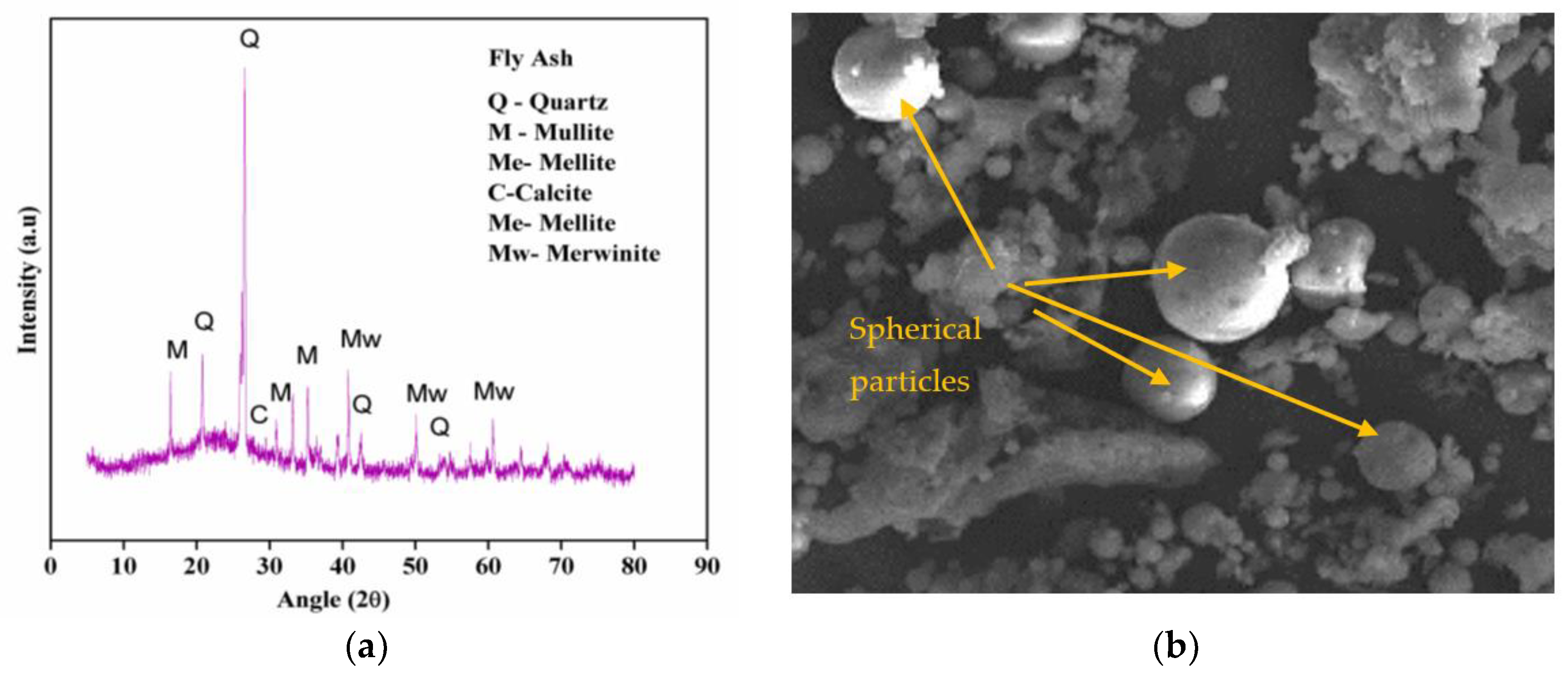
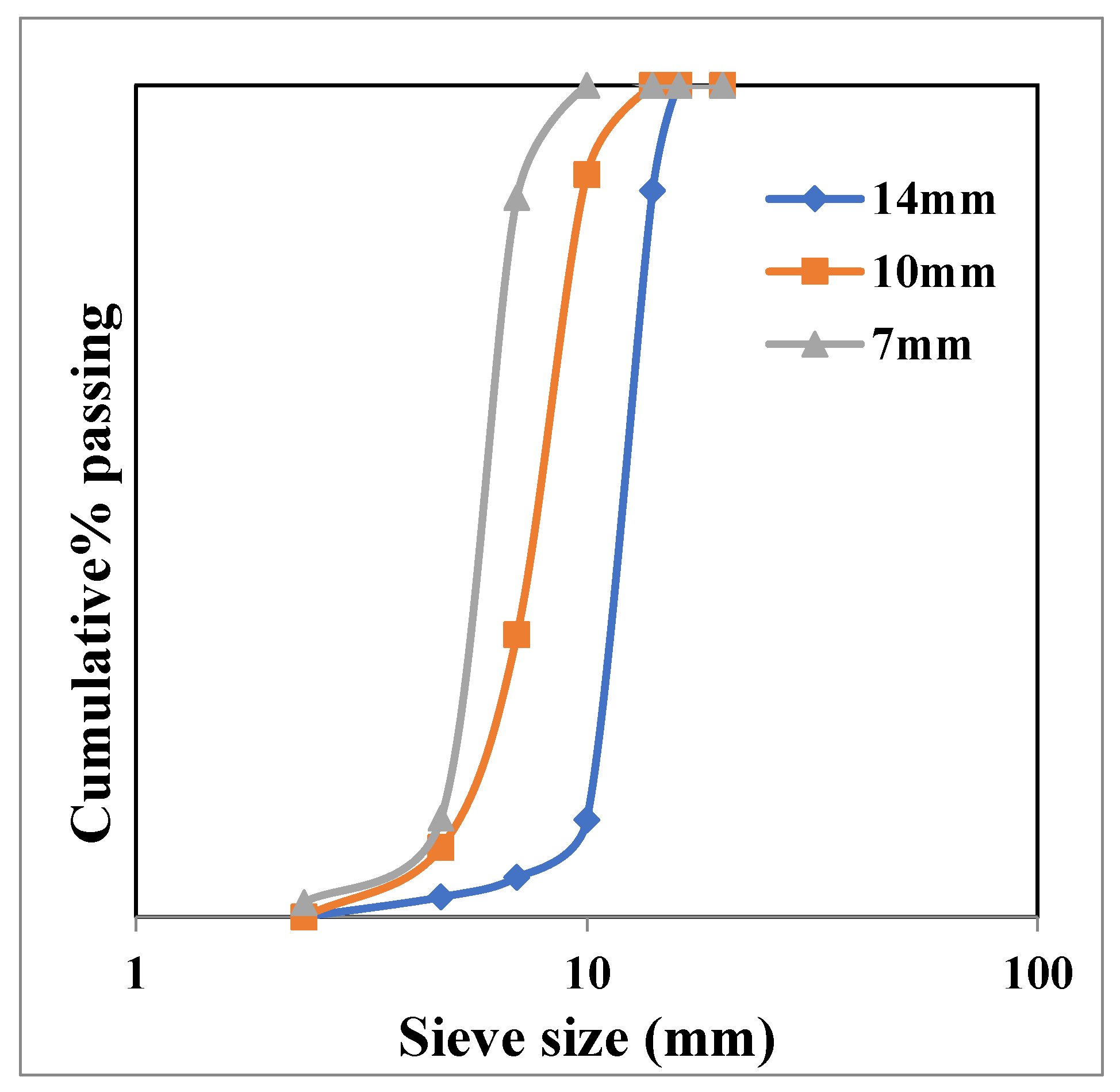
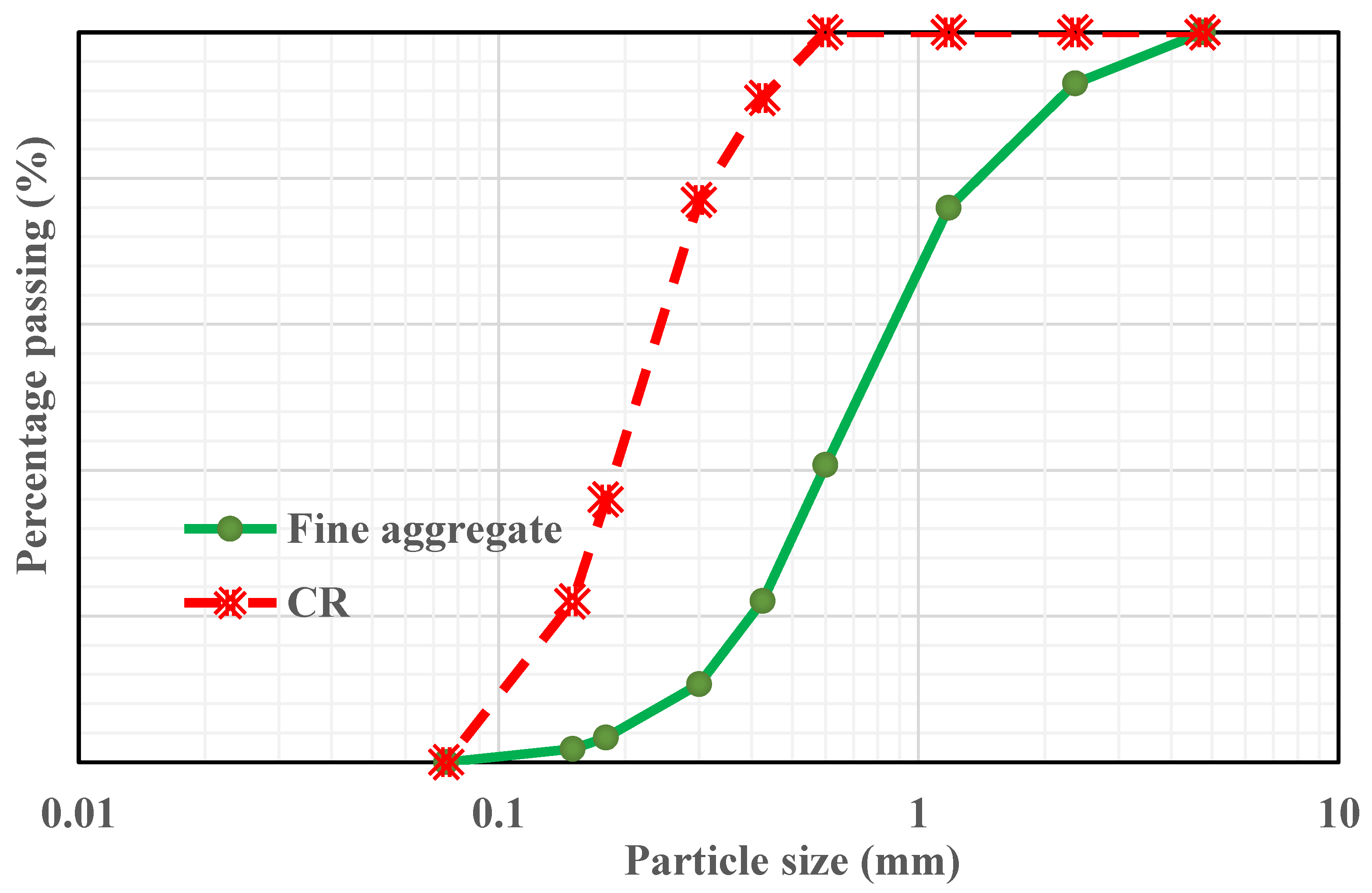
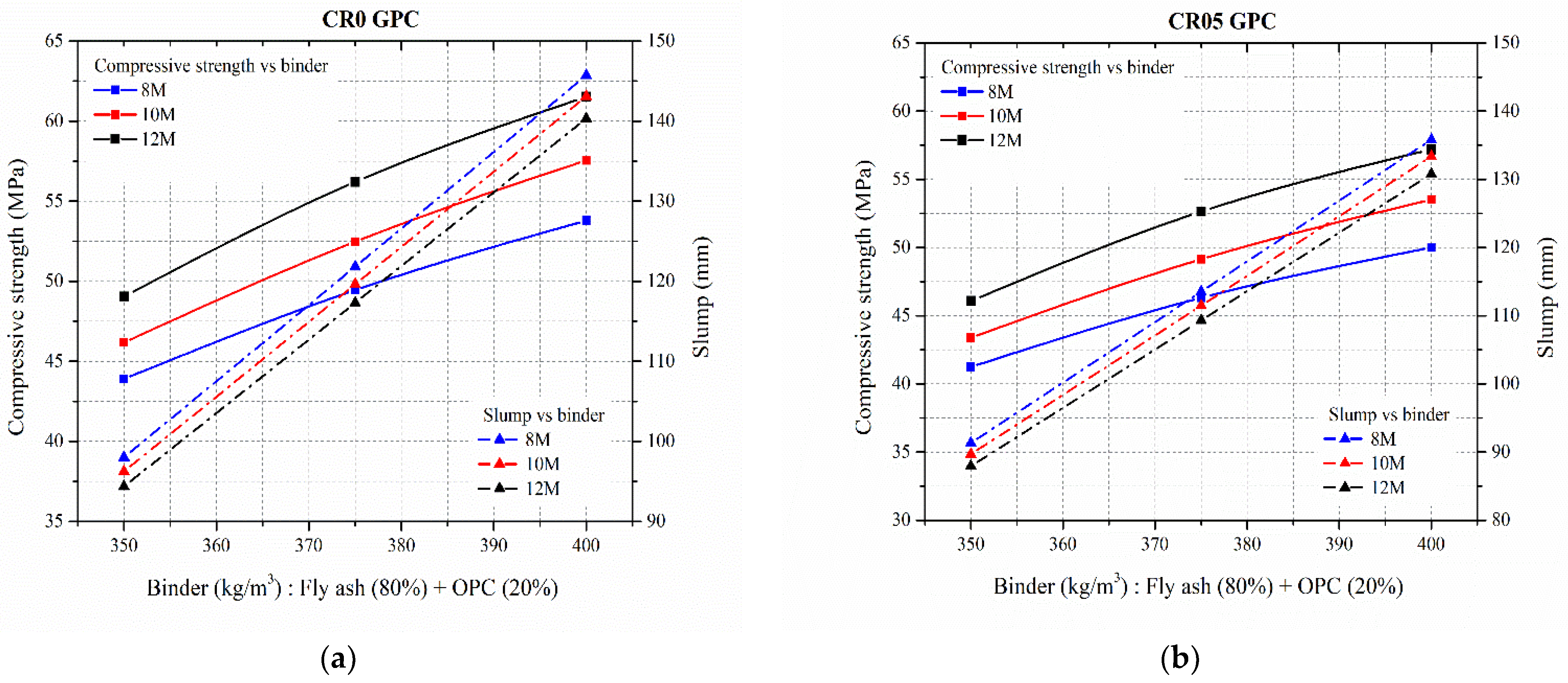

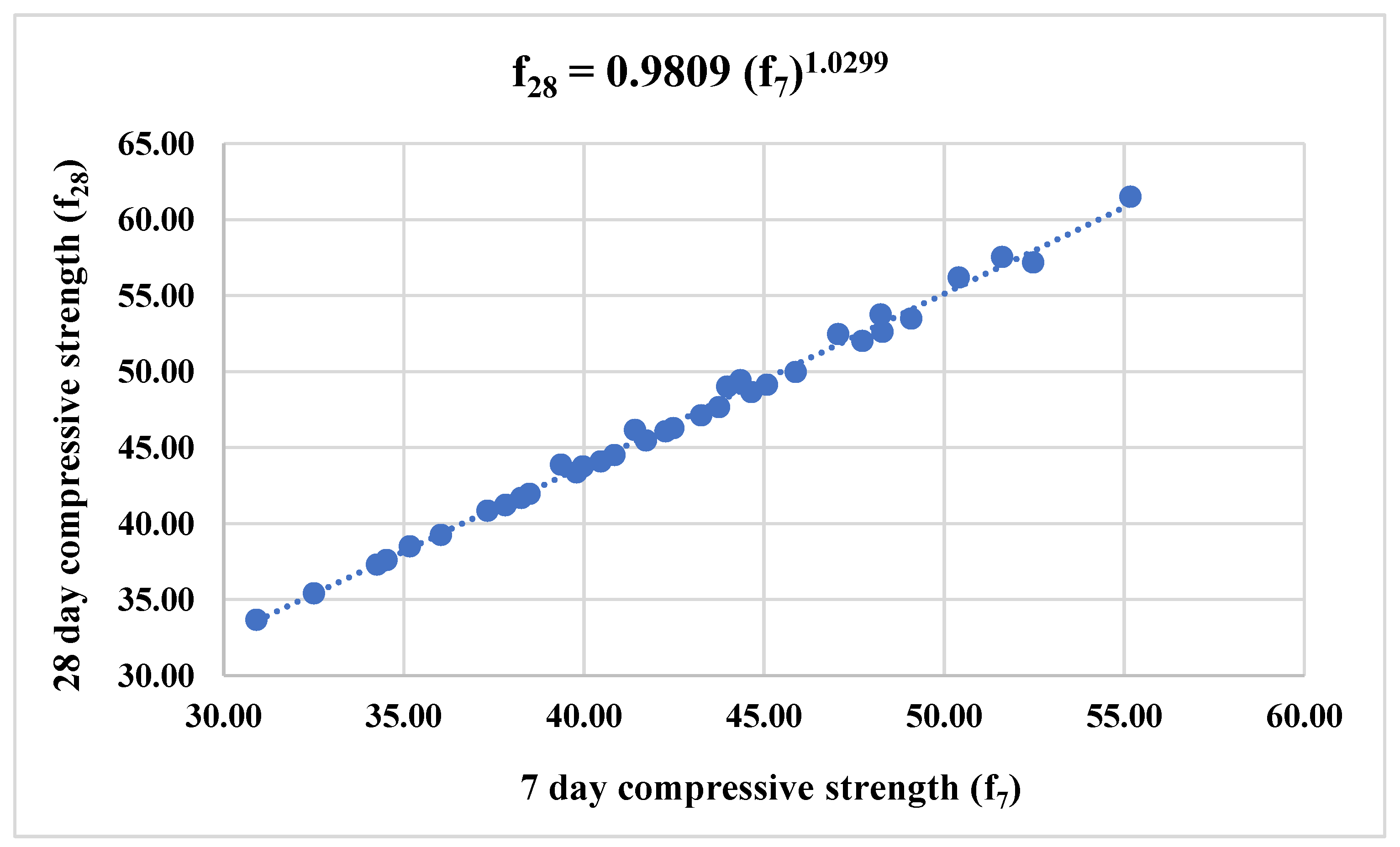
| Physical Characteristics of Fly Ash | Chemical Composition of Fly Ash | ||
|---|---|---|---|
| Characteristic | Values | Chemical Composition | Weight (%) |
| Specific density | 1.9 | Total silica (SiO2) | 60.17 |
| Blaine’s fineness (m2/kg) | 390 | Alumina (Al2O3) | 21.66 |
| Particles retained on 45 micron IS sieve (wt.%) | 27.3 | Iron Oxide (Fe2O3) | 6.33 |
| Mean particle size (μm) | 21.43 | Calcium Oxide (CaO) | 7.57 |
| Color | Gray | Total Sulfur (SO3) | 1.15 |
| Magnesium Oxide (MgO) | 0.69 | ||
| Available alkali (Na2O) | 0.31 | ||
| Physical Property | Value |
|---|---|
| Fineness (m2/kg) | 320 |
| Initial setting time (min) | 35 |
| Final setting time (min) | 565 |
| 28-day compressive strength (MPa) | 47.31 |
| Chemical Composition | Weight (%) |
| Silica (SiO2) | 19.21 |
| Alumina (Al2O3) | 7.64 |
| Iron Oxide (Fe2O3) | 5.36 |
| Total Sulphur (SO3) | 3.21 |
| Calcium Oxide (CaO) | 63.44 |
| Potassium Oxide (K2O) | 0.78 |
| Sodium Oxide (Na2O) | 0.36 |
| Loss on Ignition (LOI) | 1.91 |
| Property | Coarse Aggregates |
|---|---|
| Specific Gravity | 2.66 |
| Fineness Modulus | 7.10 |
| Water Absorption | 0.87% |
| Properties | Fine Aggregates | CR |
|---|---|---|
| Specific density | 2.65 | 1.13 |
| Bulk density (kg/m3) | 1656 | 502 |
| Water absorption (%) | 1.4 | - |
| Fineness modulus | 2.8 | 3.1 |
| Mixture | FA | OPC | CR | Sand | CA | M: NaOH | NaOH | Na2SiO3 | Extra Water | SP | Curing Temp. (°C)/24 h |
|---|---|---|---|---|---|---|---|---|---|---|---|
| B1CR0 | 280 | 70 | - | 532.7 | 1242.9 | 8/10/12 | 45.0 | 112.5 | 25.3 | 7 | 60 |
| B2CR0 | 300 | 75 | - | 515.1 | 1201.8 | 8/10/12 | 48.2 | 120.5 | 27.1 | 7.5 | 60 |
| B3CR0 | 320 | 80 | - | 497.5 | 1160.7 | 8/10/12 | 51.4 | 128.6 | 28.9 | 8 | 60 |
| B1CR5 | 280 | 70 | 11.36 | 506.0 | 1242.9 | 8/10/12 | 45.0 | 112.5 | 25.3 | 7 | 60 |
| B2CR5 | 300 | 75 | 10.98 | 489.3 | 1201.8 | 8/10/12 | 48.2 | 120.5 | 27.1 | 7.5 | 60 |
| B3CR5 | 320 | 80 | 10.61 | 472.6 | 1160.7 | 8/10/12 | 51.4 | 128.6 | 28.9 | 8 | 60 |
| B1CR10 | 280 | 70 | 22.71 | 479.4 | 1242.9 | 8/10/12 | 45.0 | 112.5 | 25.3 | 7 | 60 |
| B2CR10 | 300 | 75 | 21.96 | 463.6 | 1201.8 | 8/10/12 | 48.2 | 120.5 | 27.1 | 7.5 | 60 |
| B3CR10 | 320 | 80 | 21.21 | 447.7 | 1160.7 | 8/10/12 | 51.4 | 128.6 | 28.9 | 8 | 60 |
| B1CR15 | 280 | 70 | 34.07 | 452.8 | 1242.9 | 8/10/12 | 45.0 | 112.5 | 25.3 | 7 | 60 |
| B2CR15 | 300 | 75 | 32.94 | 437.8 | 1201.8 | 8/10/12 | 48.2 | 120.5 | 27.1 | 7.5 | 60 |
| B3CR15 | 320 | 80 | 31.82 | 422.8 | 1160.7 | 8/10/12 | 51.4 | 128.6 | 28.9 | 8 | 60 |
| Mix | EM-35 | EM-35 | EM-40 | EM-40 | EM-40 | EM-40 |
|---|---|---|---|---|---|---|
| Target strength (MPa) | 43.25 | 43.25 | 48.25 | 48.25 | 48.25 | 48.25 |
| Target slump (mm) | 90 | 90 | 90 | 90 | 90 | 90 |
| Fly ash | 300.00 | 316.00 | 304.00 | 288.00 | 300.00 | 312.00 |
| OPC | 75.00 | 79.00 | 76.00 | 72.00 | 75.00 | 78.00 |
| Coarse Aggregates | 1198.16 | 1169.11 | 1189.91 | 1222.95 | 1201.82 | 1181.21 |
| Fine aggregate | 436.47 | 425.81 | 458.96 | 497.92 | 489.31 | 480.92 |
| Crumb rubber | 32.84 | 32.04 | 21.75 | 11.17 | 10.98 | 10.79 |
| NaOH | 48.21 | 50.79 | 48.86 | 46.29 | 48.21 | 50.14 |
| Molarity[M] | 12 | 10 | 12 | 12 | 10 | 8 |
| Na2SiO3 | 120.54 | 126.96 | 122.14 | 115.71 | 120.54 | 125.36 |
| Extra water | 30.35 | 28.55 | 30.75 | 29.14 | 27.10 | 24.59 |
| Plastisizer | 7.50 | 7.90 | 7.60 | 7.20 | 7.50 | 7.80 |
| Expected compressive strength [MPa] | 43.75 | 43.5 | 48.5 | 48.5 | 48.75 | 48.5 |
| Tested compressive strength [MPa] | 44.43 | 45.08 | 49.35 | 48.93 | 49.51 | 49.77 |
Publisher’s Note: MDPI stays neutral with regard to jurisdictional claims in published maps and institutional affiliations. |
© 2022 by the authors. Licensee MDPI, Basel, Switzerland. This article is an open access article distributed under the terms and conditions of the Creative Commons Attribution (CC BY) license (https://creativecommons.org/licenses/by/4.0/).
Share and Cite
Gill, P.; Parveen. Development of Detailed Mix Design Methodology for Low Calcium Fly Ash Based Geopolymer Concrete Incorporating OPC and Crumb Rubber. Infrastructures 2022, 7, 149. https://doi.org/10.3390/infrastructures7110149
Gill P, Parveen. Development of Detailed Mix Design Methodology for Low Calcium Fly Ash Based Geopolymer Concrete Incorporating OPC and Crumb Rubber. Infrastructures. 2022; 7(11):149. https://doi.org/10.3390/infrastructures7110149
Chicago/Turabian StyleGill, Parmender, and Parveen. 2022. "Development of Detailed Mix Design Methodology for Low Calcium Fly Ash Based Geopolymer Concrete Incorporating OPC and Crumb Rubber" Infrastructures 7, no. 11: 149. https://doi.org/10.3390/infrastructures7110149






